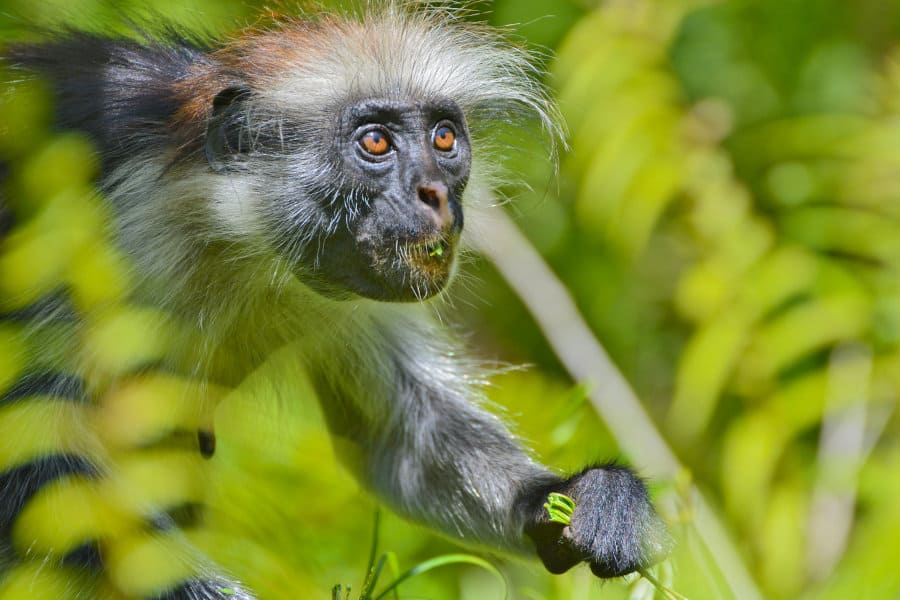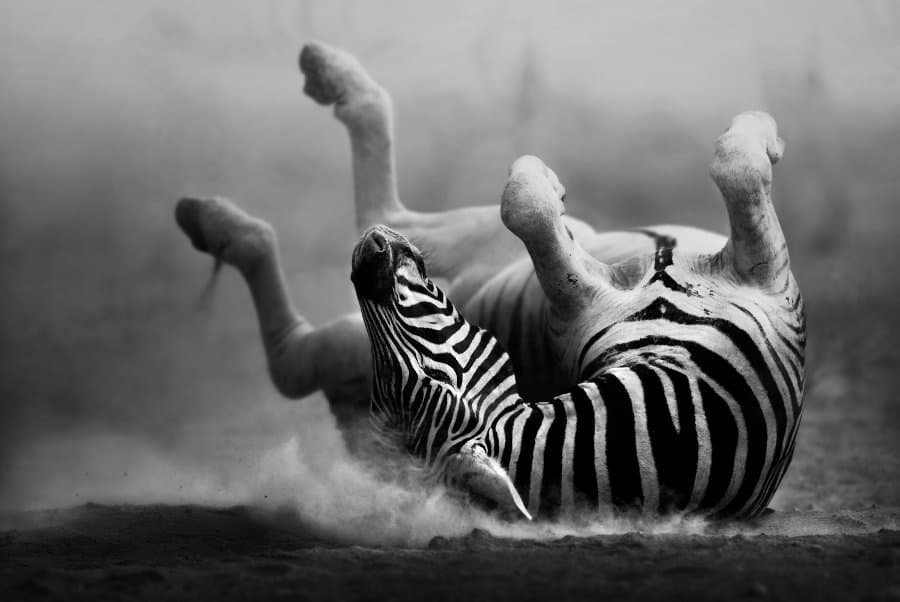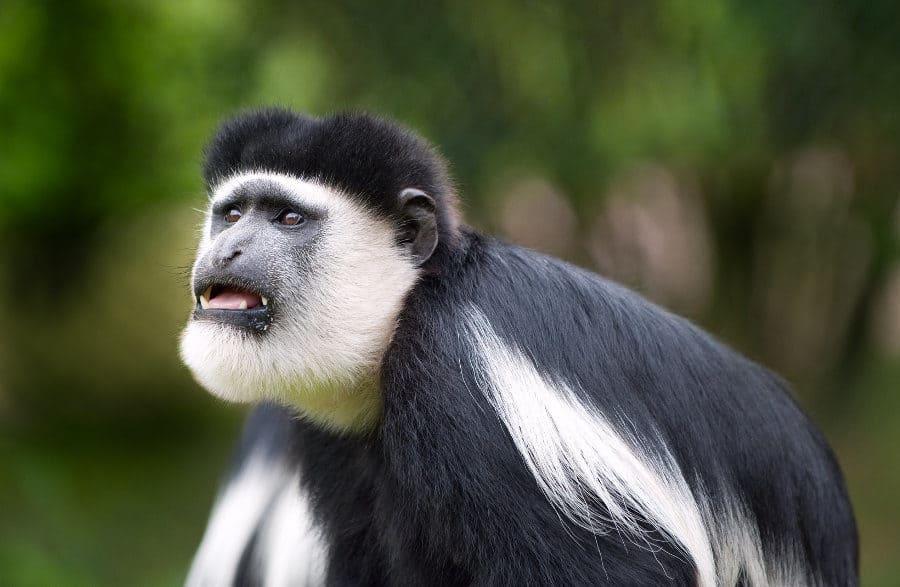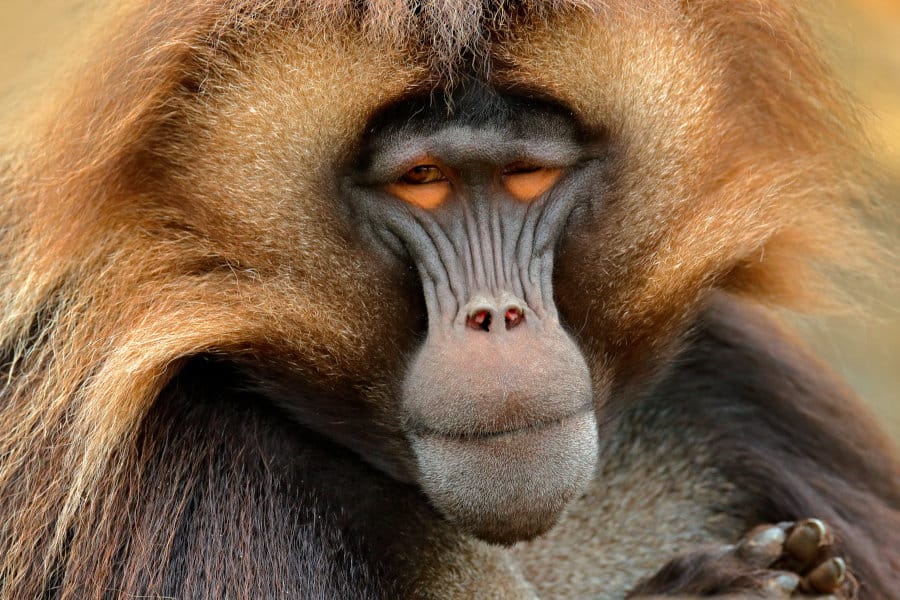Jozani Forest, located in East Zanzibar, is an untouched and preserved area of forest (shamba in Swahili). It is a popular destination for tourists, especially those on their way to the beautiful East Coast beaches of Paje and Jambiani.
The forest forms part of Jozani Chwaka Bay National Park, the only national park on the island of Zanzibar.
This fascinating destination has plenty to see, including the famous endemic red colobus monkeys. However, they’re not the only species to call this place home.
The forest supports a myriad of African animals. Here, you can marvel at different monkey species climbing along the branches of towering trees.
Spot rare antelope gracefully roaming around in the lush vegetation. As you venture through the forest, there’s also an array of plant and tree species to admire.
To help prepare for your adventure, this guide highlights the best times to visit, how to get there, what to see, and other essential tips. So let’s start planning your serene escape to Zanzibar!
Best Time to Visit Jozani Forest

You can explore Jozani Forest all year round. It’s open to visitors daily from 7:30 am to 5:00 pm. While you can visit throughout the year, it’s best to go during Zanzibar’s dry season, between June and September.
Nature walks can be challenging in the wet season due to the substantial rainfall and slippery trails.
If you plan your visit during the warmer months, enjoy the pleasant weather and relax on one of the stunning beaches in Zanzibar.
Tip: Check out the best times to visit Tanzania for a perfectly timed trip.
How to Get to Jozani Forest, Zanzibar
Before you can meet red colobus monkeys in Zanzibar’s Jozani Forest, you’ll need to know how to get there.
Fortunately, Jozani is easily accessible from most parts of Zanzibar. It’s roughly a 30-minute drive from the capital city, Stone Town.
You can take a taxi, arrange a private driver, or hire a car or scooter to get to the park. If you want to skip the logistics, consider booking an organized tour that includes transportation.
You can also travel by dala dala, which are public minibuses. The downside of this is that there is no fixed schedule. So you can’t pre-book tickets and might have to wait, as the buses depart when they are full.
What to See in Jozani Forest: Red Monkeys in Zanzibar & More
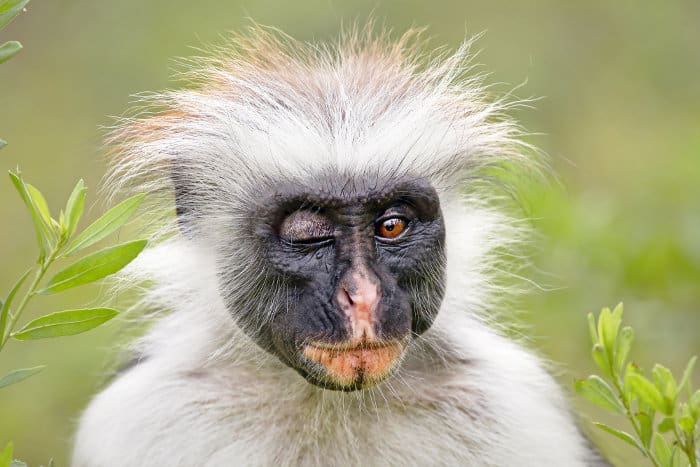
Upon arrival at Jozani Forest, you will be introduced to your guide, who will show you around the area on foot and also provide you with lots of relevant information and facts about the park and its wildlife inhabitants.
As well as the forest being a beautiful and amazing place to visit in terms of its surroundings, there is also the appeal of the wildlife which exists there, the most famous of which is the red colobus monkey – native to Zanzibar.
You can take your time to observe their habits and watch how they eat, climb, and even how the younger monkeys play and pretend to fight with each other.
As you explore Jozani, your senses will be awakened. Your nose will pick up natural scents, your ears the sounds of the forest, and your eyes will be spoiled for choice with so much wildlife and vibrant shrubbery.
Jozani Forest Animals
Monkeys may be the first animals that come to mind, but Zanzibar wildlife is diverse. These adorable primates aren’t the only animals in Jozani Forest.
Here, you can admire diverse fauna and rare species like the Kassina Jozani frog and Aders’s duiker.
Below are some fascinating creatures you may encounter during your trip.
Zanzibar red colobus monkey

You might already know that the endangered red colobus monkey is one of the most famous residents of Jozani Forest. Sadly, their population is declining, with less than 2000 individuals remaining.
You won’t miss these cute primates with their striking appearance. However, it’s worth noting that the looks of each species of red colobus monkey differ slightly.
The Zanzibar red colobus monkey’s fur ranges from dark red to black, with a black stripe running along its shoulders and arms.
These Zanzibar monkeys have distinct black faces with long white hair and a notable pink mark on their lips and nose. They have a lighter underside and a long tail.
Bird species

If you’re a birder, prepare for a treat! Jozani Forest is home to numerous bird species, including migratory and endemic varieties.
These beautiful African birds come in all shapes and sizes, from the colourful Fischer’s turaco to the little greenbul.
Other species include the African palm swift, cattle egret, barn owl, red-eyed dove, and the African goshawk.
As you stroll through the forest, take a moment to appreciate the melodious calls. Witness these winged creatures soar above you, and snap a few photos to capture the moment.
Butterflies
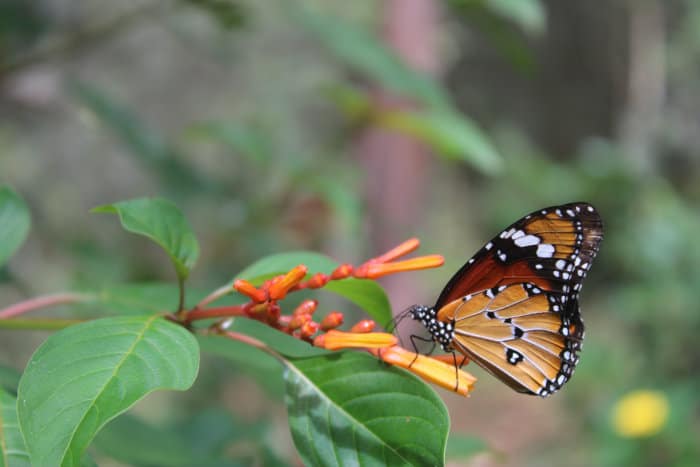
Jozani Forest is teeming with fluttering beauties that are truly a feast for the senses. Species like the African monarch – pictured above – fly through the forest with their delicate, colorful wings, adding to the enchanting atmosphere.
With an array of butterfly and bird species, it’s a haven for birders and nature enthusiasts, so be sure to bring your binoculars along.
If you want to see more butterflies, make your way to the Zanzibar Butterfly Center. Here you can admire hundreds of endemic butterflies.
Antelope
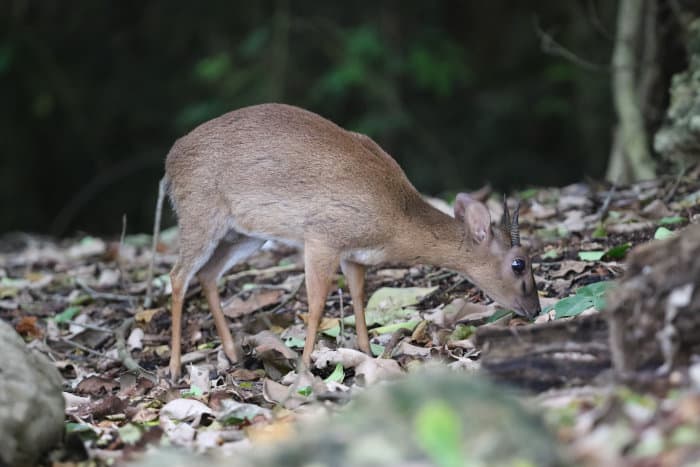
Are you hoping to see some African animals with horns? Well, you’ll be happy to know that there are several elegant African antelope in Jozani Forest.
The Aders’s duiker is one of the incredible species residing in the area.
This forest-dwelling duiker is a rare creature with a petite, reddish-brown body. They stand around 30 cm at the shoulder, boasting a pointed muzzle and small, simple horns.
The Aders’s duiker is quite shy, so don’t expect them to come up to you and say hi.
But you may get lucky enough to catch a glimpse of them during your visit. Keep an eye out for antelope roaming around or hiding in the bushes.
You may also see the unique suni antelope in the forest. This exquisite animal is one of the smallest antelope in Africa.
Tip: If you want to learn more about minute horned animals, check out these facts about the dik-dik.
Diverse reptiles
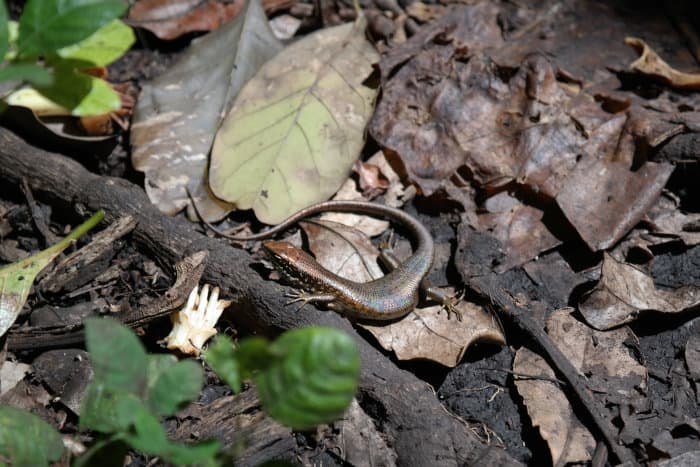
Ready for a rendez-vous with reptiles? In Jozani Forest, there are chameleons, rare lizard species, venomous African snakes, and other creatures deep in the rainforest.
While there are poisonous snakes like green and black mambas, don’t fret, as these serpents typically prefer to stay in the dense forest. So, the further you walk, the higher your chances are of seeing them.
Now, on to the more harmless critters. You may spot lizards, geckos, tortoises, and chameleons. Watch how the chameleon seamlessly blends with its surroundings, rotating its eyes as the rest of its body remains still.
It’s truly impressive!
As the ocean surrounds Jozani Forest, it’s also an excellent spot to admire sea turtles. You can learn more about these mesmerizing animals at the Jozani Sea Turtle and Tortoise Sanctuary.
Tip: If you’re wondering what the main differences between these two shelled creatures are, check out some interesting facts on the turtle vs. tortoise.
What to Wear When Visiting Jozani Monkey Forest, Zanzibar
How do you dress when touring Jozani? Of course, you want to be comfortable, especially when it comes to your footwear. Here are a few clothing items and accessories to pack:
- Lightweight clothing – long-sleeved tops and full-length pants are great options. When deciding what to wear, it’s best to stick to strong natural fabrics like cotton, linen, hemp, and wool.
- Well-fitting walking shoes – sneakers and waterproof footwear is preferable.
- A hat or cap, sunscreen, and sunglasses – provide defense against the sun’s rays.
- A water bottle – it’s best to keep hydrated during your adventure.
- Insect repellent – this comes in handy to ward off bugs.
- Camera equipment – don’t forget to capture the stunning sights and memorable moments.
When visiting Stone Town and other villages, it’s best to dress modestly to respect the Islamic culture.
Long skirts, maxi dresses, loose-fitting pants, and scarves are excellent options for appropriate attire. The scarf comes in handy to drape over your shoulders when heading out.
Remember, it’s respectful to cover from the shoulder to the knee and avoid clothing that exposes your chest, midriff, and thighs.
Tip: For more outfit inspiration and gear recommendations, check out this article on safari clothing.
Jozani Forest: Frequently Asked Questions
As you prepare for your encounter with the beautiful flora and fascinating creatures, including the monkeys of Zanzibar, you may still have some lingering questions.
Here are the answers to a few commonly asked questions to help you plan the perfect trip to Jozani Forest.
How much does it cost to go to Jozani Forest?
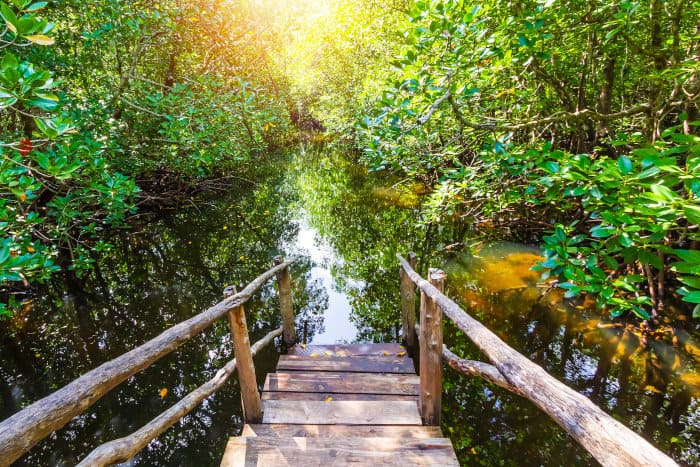
The Jozani Forest entrance fee is around $7.30 (or approximately $10 if you pay in local currency).
Be sure to bring extra cash to show appreciation and tip the guide.
Can you go to Jozani Forest without a guide?
No, you cannot explore Jozani Forest on your own. Visitors are not allowed to venture off the trails in Jozani Chwaka Bay National Park without an official guide.
Luckily, having a guide is part of the entrance fee. While discovering the hidden gems in the forest, you’ll have a knowledgeable escort sharing insightful information on the area.
Is Jozani Forest worth it?

Yes! Jozani Forest is certainly worth a visit. The unique plant and tree species make it a treat to the eyes and a spectacular source of natural remedies.
This tranquil location is also home to diverse animal species, including the red colobus and blue monkeys.
Ready to Explore Zanzibar’s Monkey Forest?
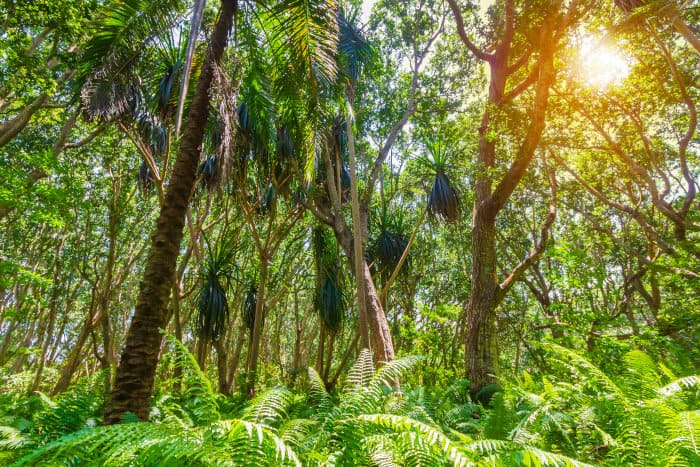
So, there you have it, the ultimate guide to visiting the breathtaking Jozani Forest. Whether you’re hoping to see rare antelope or famous Zanzibar monkeys, Jozani Forest has something for everyone.
Immerse yourself in the lush greenery and take in the tranquil ambiance as you listen to the birds chirping in this magical forest.
With incredible views that’ll take your breath away and rich biodiversity, it certainly deserves a spot on your travel bucket list.
We recommend a visit to Jozani for anyone staying in Zanzibar. It may not be the same as going on a mainland Tanzania safari, but it offers a totally different and fascinating experience anyway.
And if you’re planning more adventures on the continent, book an African safari, adding to your wonderful travel memories in the wild.
